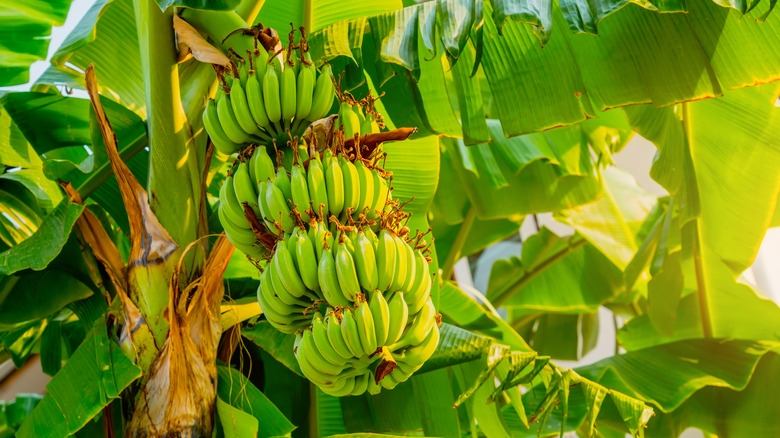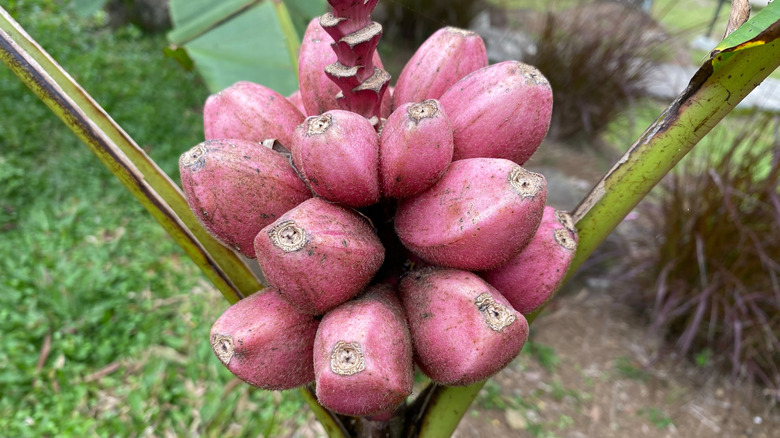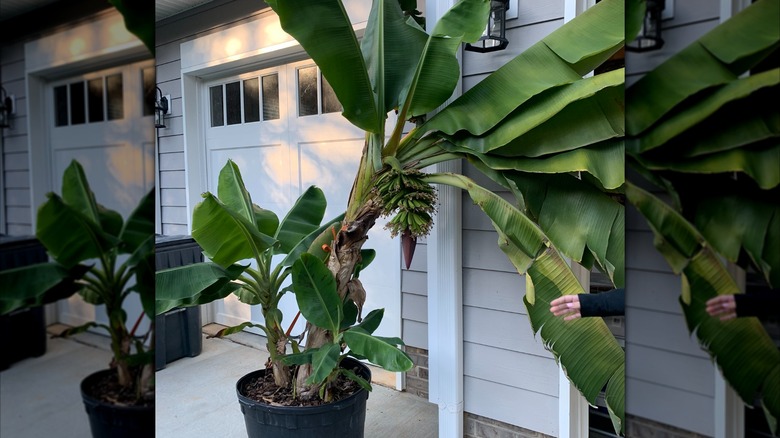Can You Really Grow Bananas From Seed? Here's What To Know
Ever wondered whether you could grow a whole tree from the banana you just bought? Turns out you cannot, for the most part, and even if you could, bananas don't grow on a tree; they're botanically a really tall herb. Growing fruit trees from seed is more complicated than you think, and this complication is even more pronounced for bananas. "Most of the bananas you find in grocery stores, like the common Cavendish, don't actually have viable seeds," says master gardener and fruit tree grower Josh Gardens in his exclusive interview with House Digest. "If you've ever noticed those tiny black specks in the center, those are underdeveloped seeds that can't germinate. Because of how bananas have been bred for human consumption, these fruits are seedless, making them convenient to eat but impossible to grow from seed."
But before you lose all hope, here's a catch: you may have a fighting chance with wild (not cultivated) varieties. "Wild bananas, on the other hand, produce large, hard seeds that can grow into banana plants," explains Gardens. But he cautions that these bigger seeds leave little room for edible flesh. Worse still, they aren't the easiest fruits to grow from seeds in your backyard. This has to do with their unique genetic variations that may delay fruiting, assuming they produce at all. Plus, getting the seeds to germinate can be complicated.
How to grow wild and ornamental bananas from seed
Seeds can be a lovely method to experiment with niche banana varieties and the edible red banana (Ensete ventricosum 'Maurelii'). You may also grow ornamental selections from seed — Gardens makes the case for "Musa velutina, known for its small pink bananas with large seeds," in his House Digest exclusive. He also recommends "cold-hardy bananas like Musa basjoo" that can be grown as low as USDA Hardiness Zone 5.
Regarding the cultivation process, Gardens explains, "First, it's important to understand that wild banana seeds have a hard outer coating." To stimulate germination, the first step is seed scarification, or nicking them with a file or sandpaper. "After scarifying, soak the seeds in warm water for 24 to 48 hours. This helps soften the seed coat further and encourages sprouting," Gardens says. To closely mimic the tropical conditions available to bananas in the wild, he recommends "using a thermos or insulated container."
Moving on to the planting mix, Gardens advises, "I use a well-draining potting mix with added perlite or coarse sand for drainage, combined with organic material like coconut coir or peat moss to retain moisture." This keeps the soil sufficiently moist (without growing soggy) and retains humidity around the seeds. Once ready, "Plant the seeds about ¼ to ½ inch deep in individual pots or seed trays," he suggests. Use a heat mat to maintain soil temperatures between 75 and 85 degrees Fahrenheit. Or, just heat the mat once and leave it to cool to create oscillating temperatures. The seeds may "take anywhere from three weeks to several months" to germinate, per Gardens.
Planting seed-grown bananas and separating pups
After the seeds germinate, hold off on popping them into the garden soil right away. Instead, "Once seedlings sprout, keep them under bright indirect light," says Gardens in his exclusive House Digest interview. Further, to prevent the plants from growing root-bound, repot them in a bigger container annually until they at least fit a one-gallon pot. "I prefer not to plant bananas in the ground until they've reached at least a one-gallon size, though two- or three-gallon pots make for stronger transplants," adds our expert. He also warns that, "During this process, you may notice pups forming. Pups are small shoots that emerge from the base of the mother plant. These can be divided off once they have their own root system to create new banana plants, which I've done often."
That being said, if you're growing bananas solely for their fruit, rather than seeds, you must grow them from these pups or suckers. As pups are "essentially clones of the parent," Gardens says, you are assured of the exact fruit quality, unlike with seeds. They're sold commercially, or if you know a banana plant owner, you may separate your own with a sharp shovel when "they're at least 3 to 4 feet tall and have a good root system developed" and show over five leaves. Be "sure to take a section of the underground rhizome with it," adds Gardens. This is because it'll arm the pup with adequate energy to support itself in a new location.


